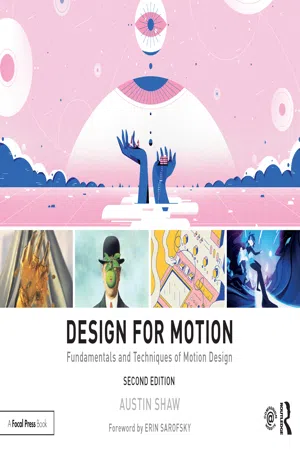
- 380 pages
- English
- PDF
- Available on iOS & Android
About this book
Combining art and design principles with creative storytelling and professional savvy, this book covers everything a serious motion designer needs to make their artistic visions a reality and confidently produce compositions for clients.
In this updated second edition of Design for Motion, author Austin Shaw explores the principles of motion design, teaching readers how to creatively harness the essential techniques of this diverse and innovative medium to create compelling style frames, design boards, and motion design products. Lessons are augmented by illustrious full-color imagery and practical exercises, allowing you to put the techniques covered into immediate practical context. Industry leaders, pioneers, and rising stars contribute their professional perspectives, share personal stories, and provide visual examples of their work.
This second edition also includes updates on the following:
- Illustration techniques
- Typography
- Compositing
- Visual storytelling
- Incorporating 3D elements
- Social/mobile-first design
- Portfolio and concept development
- How to develop a distinct personal design style, and much more
Plumb the depths of core motion design fundamentals and harness the essential techniques of this diverse and innovative medium. An accompanying Companion Website (www.routledge.com/cw/shaw) features video tutorials, a student showcase, and more.
Frequently asked questions
- Essential is ideal for learners and professionals who enjoy exploring a wide range of subjects. Access the Essential Library with 800,000+ trusted titles and best-sellers across business, personal growth, and the humanities. Includes unlimited reading time and Standard Read Aloud voice.
- Complete: Perfect for advanced learners and researchers needing full, unrestricted access. Unlock 1.4M+ books across hundreds of subjects, including academic and specialized titles. The Complete Plan also includes advanced features like Premium Read Aloud and Research Assistant.
Please note we cannot support devices running on iOS 13 and Android 7 or earlier. Learn more about using the app.
Information
Table of contents
- Cover
- Half Title
- Title
- Copyright
- Dedication
- Table of Contents
- Acknowledgements
- Foreword to the 2nd Edition
- Preface
- List of Contributors
- Introduction: Motion Design
- Chapter 1: Design for Motion
- Chapter 2: Kick-off to Delivery
- Chapter 3: Concept Development
- Chapter 4: Image-Making & Visual Storytelling
- Chapter 5: Tools, Technology, & Techniques
- Chapter 6: Social/Mobile First
- Chapter 7: Presentations & Pitches
- Chapter 8: Creative Briefs for Portfolio Development
- Chapter 9: Type-Driven Design Boards
- Chapter 10: Illustrative Design Boards
- Chapter 11: Info-Driven Design Boards
- Chapter 12: Tactile Design Boards
- Chapter 13: Character-Driven Design Boards
- Chapter 14: Modern Design Boards
- Chapter 15: Looking Forward
- Index